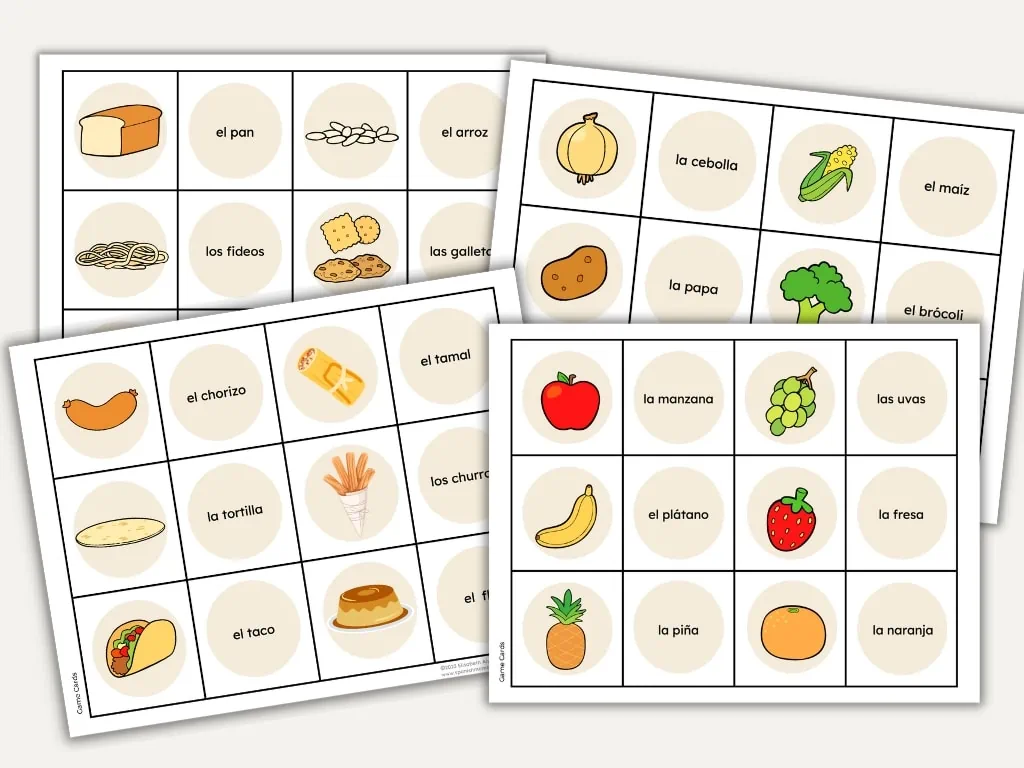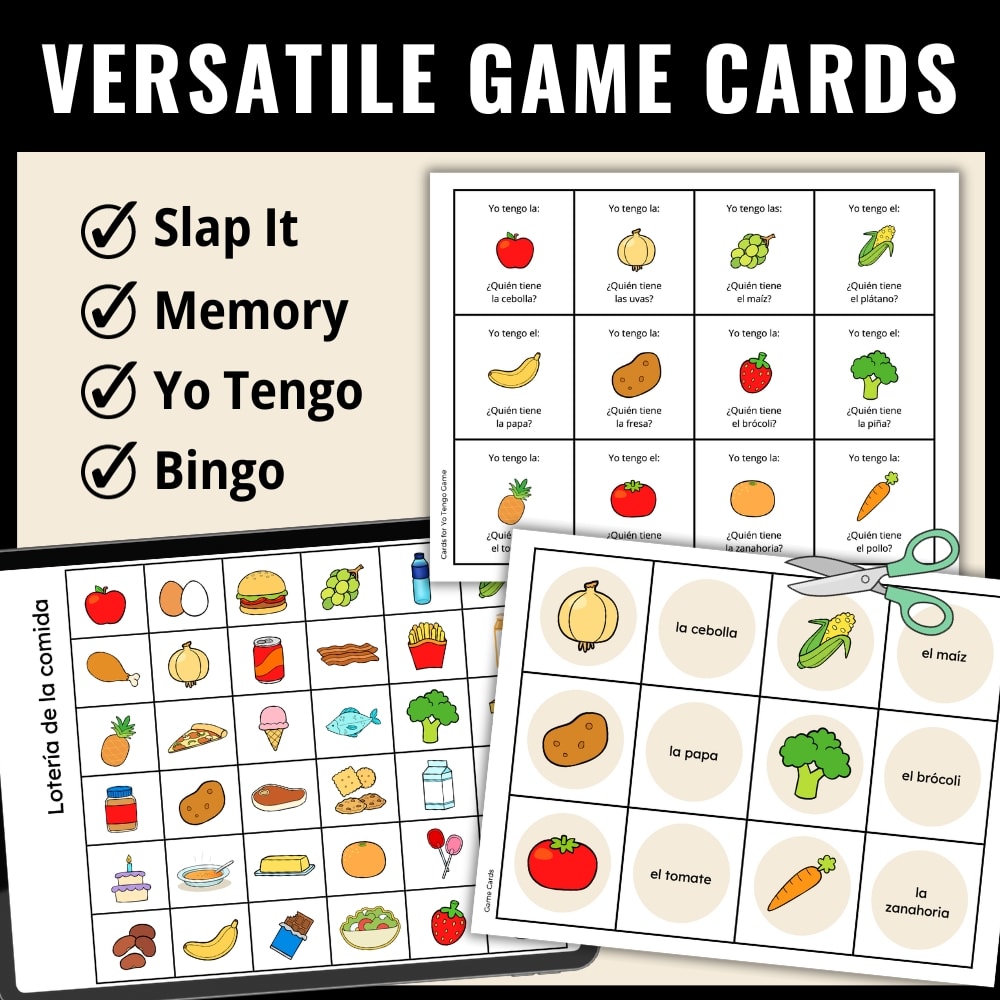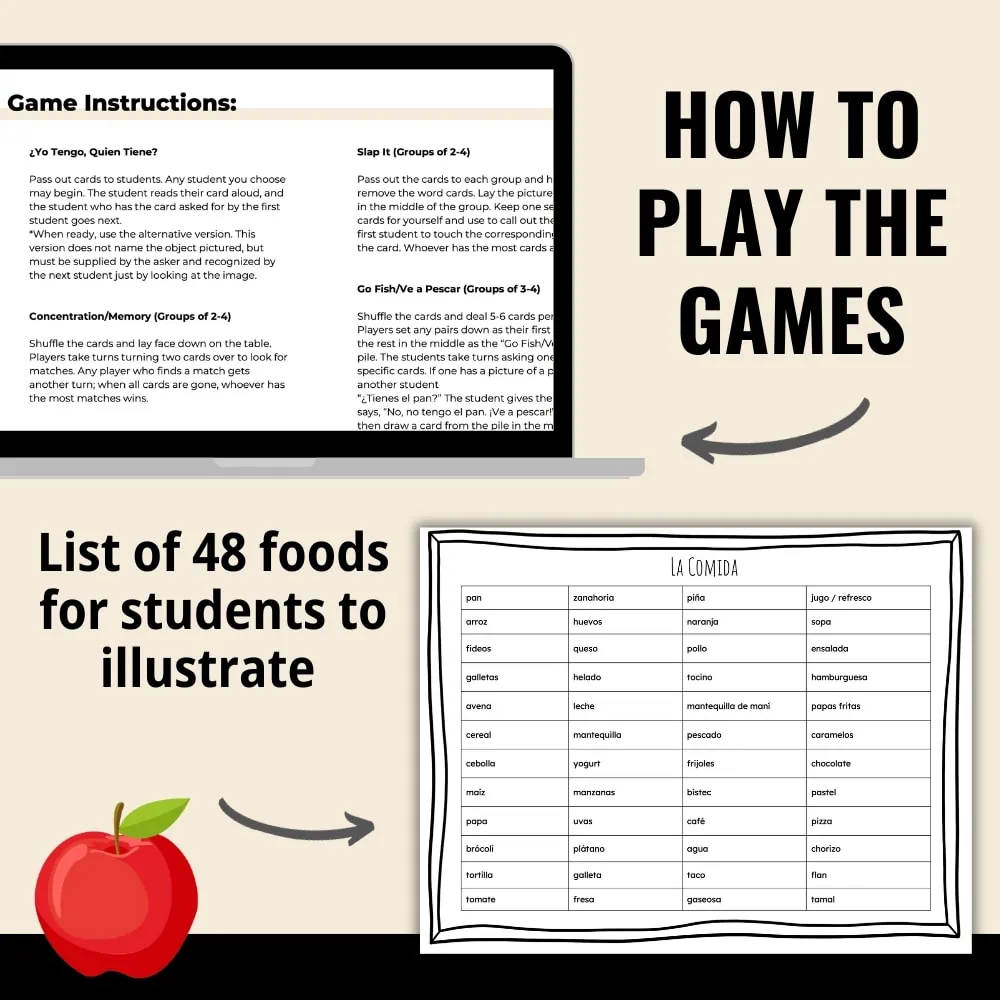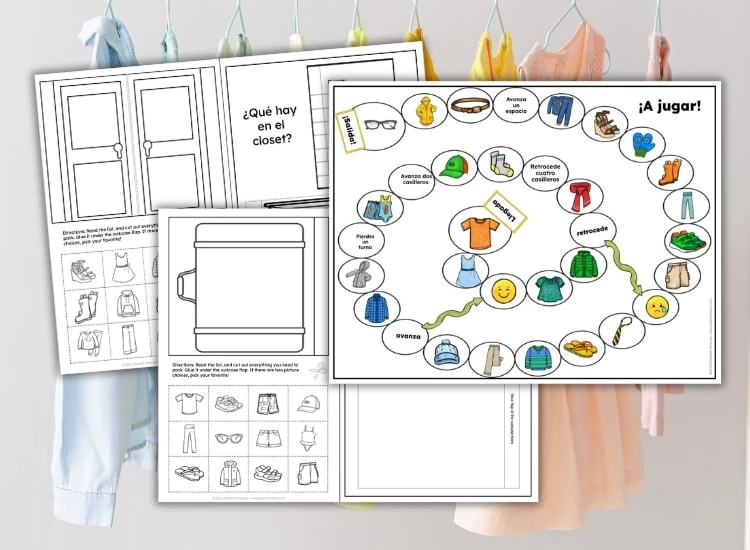Spanish Food Vocabulary Games
Inside: Free food in Spanish printable worksheets in PDF form and ideas for teaching food vocabulary in Spanish.
Teaching Spanish food terms is super fun! It’s relevant to all of your students and one of the real-life situations they would face when traveling.
If you know me, you know I often avoid long vocabulary lists on one topic. In the case of food, I make an exception: you can do so many fun, real-world activities in which your students use a ton of food terms.
Here’s what I have in this post:
1. Free Printable Worksheets
2. Food Projects for Spanish Class
3. Videos and Songs for Pronunciation
4. Common Food Vocabulary in Spanish
5. Example dialogue when ordering food in a restaurant.
I especially love food units with preschool and elementary students because they get so into it, and can use the vocabulary in their daily life!
Free Food in Spanish Worksheets
I have these pages with adorable images of food as a free resource! It’s a PDF of cards that include 40 common foods in Spanish. You can use them for flash cards, reference posters, or game cards. The only prep needed is to print onto cardstock and cut them out.
The printable activities include game ideas for using the cards with different levels! You can play Slap-It, Memory / Concentration, Go Fish, or Old Maid.
I do have the entire 59-page packet as well. It includes Bingo games, dice games, Guess Who game for including adjectives, a crossword puzzle, wordsearch puzzles, and answer keys.
Food Projects for Spanish Class
Once your students are familiar with their new Spanish words, what are fun activities you can do in class to work with the language in context? Here are my favorite ideas:
1. Talk About Likes and Dislikes
For a beginner’s activity, write on the board or give students a sheet with “no me gusta,” “me gusta,” and “me encanta.” With very beginning students, give them the food picture cards and let them sort into categories. Students who mostly know the words can use just the word cards.
For a brain break or movement, you can also designate different corners of the room as “no me gusta,” “me gusta,” and “me encanta.” Call out different foods in Spanish, and students move to the corner that fits them!
You can also choose 5-10 foods and do a poll to see which ones are favorites to least favorite, all in Spanish.
2. Do a Virtual Shopping Trip
Use a grocery store from a Spanish-speaking country. Give students a list of foods to buy (1 kilo de manzana, 1 litro de leche, etc.). They can use the links to find each item, “buy it” by writing down the price, and totaling at the end to see how much they spent (to work a little math in!).
Most online supermercados tend to show alcohol on the homepage, so I would give them direct links like this:
https://www.wong.pe/frutas-y-verduras
https://www.wong.pe/lacteos
https://www.wong.pe/panaderia-y-pasteleria
https://www.wong.pe/carnes-aves-y-pescados
You can also take screenshots and use those in your lessons!
3. Create a Restaurant
My students always love this one. I divide them into groups, and they create a restaurant with menus, prices, etc. Then we do skits or practice visiting each other’s restaurante.
(See below for sample dialogue for restaurant vocabulary!)
4. Cook in Class
Don’t be intimidated by this one– there are some super simple recipes and ideas you can do! I have a fantastic list here of recipes to make in Spanish class.
As another project option, you can have students do a “cooking show” with play dough, or do a video of themselves at home, speaking in Spanish to follow a recipe.
5. Create a Spanish Market
This one is great if you have younger kids and need to keep it kind of simple. Create a mini-mercado with plastic food or pictures of food and prices. Give the students “money” and let them sell and shop! This is a great time to practice greetings, por favor, gracias, etc. Guide them to say “Quiero…” as they select the food, and “No quiero…” as they pass on other foods.
6. Field Trip!
With middle or high school students, going to a Latin American restaurant can be really fun. This is obviously best with smaller classes. You may want to check with the restaurant first, and make sure that the student budget for a nice tip.
Alternatively, plan a Taco Truck Day right at your school!
Intro to Food Vocabulary in Spanish Videos
Here are my favorite comprehensible videos for kids
Common Food Vocabulary Terms in Spanish
First, here are the common words for food or meals:
| comer | to eat |
| el desayuno | breakfast |
| el almuerzo | lunch |
| la cena | dinner |
| la merienda | snack |
| el postre | dessert |
12 Common Fruits in Spanish
| manzana | apple |
| plátano | banana |
| naranja | orange |
| uva | grape |
| fresa | strawberry |
| pineapple | piña |
| limón | lemon |
| sandía | watermelon |
| cereza | cherry |
| peach | melocotón |
| blueberry | arándano |
| pear | pera |
10 Common Vegetables in Spanish
| zanahoria | carrot |
| potato | papa / patata |
| tomate | tomato |
| brócoli | broccoli |
| cebolla | onion |
| maíz | corn |
| ajo | garlic |
| pepino | cucumber |
| lechuga | lettuce |
| pimiento | bell pepper |
21 More Common Food Terms in Spanish
| el pan | bread |
| el arroz | rice |
| los fideos | pasta |
| las galletas | cookies or crackers |
| la avena | oatmeal |
| el cereal | cereal |
| el huevo | egg |
| el queso | cheese |
| el helado | ice cream |
| la mantequilla | butter |
| el yogur | yogurt |
| el pollo | chicken |
| el tocino | bacon |
| la mantequilla de maní | peanut butter |
| el pescado | fish |
| los frijoles | beans |
| el bistec | steak |
| el chorizo | sausage |
| la sopa | soup |
| la ensalada | salad |
Drinks and Sweets in Spanish
| el agua | water |
| el café | coffee |
| la leche | milk |
| la gaseosa / el refresco | soft drink |
| el jugo / refresco | juice |
| el chocolate | chocolate |
| el caramelo | candy |
| el pastel | cake |
Simple Restaurant Dialogue in Spanish:
When creating a restaurant with my students, I keep the dialogue very simple, using the most common verbs and words we can.
Going to a restaurant in the morning, with breakfast foods:
Customers 1 and 2: Buenos días.
Waiter: ¡Buenos días! Aquí está la carta.
(Customers study the menu.)
Customer 1: Yo quiero un café con leche, pan, y un huevo, por favor.
Waiter: Muy bien. ¿Y para usted?
Customer: Yo quiero un jugo de naranja y huevos con tocino, por favor.
Waiter: ¿Algo más?
Customer: No, está bien.
Waiter: Muy bien.
Customer: ¡Gracias!
(Waiter brings the food.)
Waiter: Aquí está su café con leche, pan, y un huevo. Y aquí está su jugo de naranja y huevos con tocino.
Customer 1 and 2: ¡Gracias!
Waiter: Buen provecho.
(Customers eat, then motion to the waiter)
Customer 1: La cuenta,por favor.
(Waiter brings it.)
Waiter: Veintitrés dólares, por favor.
Customer 2: Aquí está.
Customer 1 and 2: ¡Gracias!
Waiter: ¡Gracias!
Here are some videos with sample situations:











Dear Elisabeth,
the links to the printable material are not working. I have bought the complete Mi vida loca package and can´t find for example “Apples to apples” or these Food Vocabulary Games.
Would really like to use them!
Kind regards,
Adriana
Hi! The link to the game cards is an orange button. Here’s the file link: https://drive.google.com/file/d/1RJIhTeJZ1dThSmfRn8tp7JpsWz8YV67P/view
Here’s the Apples to Apples post!
https://spanishmama.com/apples-to-apples-manzanas-a-manzanas/